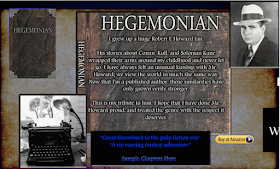This review is a month or so late, but with looming deadlines for writing projects, more on the horizon, and working 70 hour weeks, it’s a wonder it got finished at all. Lauren Bucca at Rowan & Littlefield was kind enough to mail me a review copy of this book. I’m very glad she did. I’ve read about a dozen or more academic anthologies on the various writers of Weird Tales, with an emphasis on Robert E. Howard, H.P. Lovecraft and Clark Ashton Smith. While some have been hit and miss—meaning, some of the chapters in a volume have been very good, others not so much—this volume was faithfully strong throughout.
Edited by Justin Everett and Jeffrey H. Shanks (chair and co-chair of the pulp studies for the Popular Culture Association), this volume covers nearly every aspect of Weird Tales (the pulp fiction magazine) and some of its most popular writers from the early years. There are chapters devoted to the history of Weird Tales, literary reflections, and/or movements within its pages (e.g. weird modernism), collaborations of its writers, genres that stem from it (e.g. sword & sorcery), with special attention to H.P. Lovecraft and Robert E. Howard, and other topics. While this review will not be a chapter by chapter review per se, I will attempt to cull and discuss what I thought were some of the more interesting chapters and briefly describe the others (which are also very interesting and well worth reading).
Jason Ray Carney begins the volume with a discussion about the tenuous history of Weird Tales magazine, its lower than imagined level of readership—peaking at around fifty-thousand readers at the height of its popularity. He also details just how frail the magazine’s financial state throughout its existence. This chapter brings to the forefront some surprising facts and nice information, laying the nice groundwork for the over-all volume. If you are new to Weird Tales, then by all means read this chapter.
Jonas Pridas’ chapter on modernism within the pages of Weird Tales is quite interesting. Declaring that modernist writers were published in pulp magazines, they have, none-the-less been largely ignored. He takes a birds-eye view of modernist literature (some weird and some not) inside and outside of the magazine Weird Tales. Pridas discusses trends in various Modernist frameworks of weird literature, including science, Darwinism, and devils.
Daniel Nyikos discusses Weird Tales writers within the Lovecraft Circle . This is a group that carries on regular correspondence with H.P. Lovecraft and each other, developing friendships with each other as they shared ideas, interests, and stories. Nyikos calls them a type of literary intelligentsia. This chapter was quite interesting since it details how these writers carried on with one another and their work.
Morgan T. Holmes’ chapter on the sword-and-sorcery in Weird Tales has, of course, a strong emphasis on Robert E. Howard and Conan the Cimmerian. However, Holmes also takes a look at Clark Ashton Smith and C.L. Moore’s contributions to the sword and sorcery sub-genre. Delving into the origins of sword and sorcery, Holmes demonstrates how the sub-genre develops and ultimate folds into current authors' works. He also has a section called ‘Sword-And-Sorcery Oddities’ that is intriguing, examining a few writers of note who perhaps made small but important contributions to Weird Tales and the sword and sorcery sub-genre.
Lately, scholars have been delving into issues of sex within the weird fiction genre. One such scholar is Bobby Derie, an H.P. Lovecraft aficionado. His chapter titled ‘Great Phallic Monoliths’ examines the use of sex, or the lack thereof, in Lovecraft’s stories. While some see this type of academia as fringe, even unnecessary, often times these kinds of studies uncover aspects about writers that help us understand why they used the source material they did and why they wrote some of the things they did. So, dismissing this type of critical research is not altogether wise. And, Derie is a leading scholar in this field. His chapter examines the sexual nature of Lovecraft and what various biographers and other HPL scholars have said about the topic, adding, of course, his own research to the issue.
 |
| Weird Tales, November 1932 |
Briefly, other chapters cover how the Weird Tales writers collaborated via their correspondence, and the end results (Nicole Emmelhainz), Scott Connors, a Clark Ashton Smith scholar, has a wonderful chapter titled ‘Pegasus Unbridled.’ Connors discusses the harsh reality of the pulps being reduced to a kind of “ghettoization” and why, perhaps, that wrongfully occurred. Geoffrey Reiter discusses world building in the works of Clark Ashton Smith. Jonathan Helland delves into gender, women, Brundage, and C.L. Moore , in the October 1934 Weird Tales issue. Lastly, Paul W. Shovlin has a chapter devoted psychological “madness” of Robert Bloch’s weird stories, and Sidney Sondergard discusses what he aptly sub-titles ‘Harold Lawlor’s Self-Effacing Pulp Fiction.’
Having already read about a dozen academic anthologies devoted to Lovecraft, Howard, and even Clark Ashton Smith, as well as other pulp writers and writers of weird tales, I can safely say this is one of the better collections. And even though it has a hefty price tag (even the eBook is a bit high), it is very much worth it if you are interested in delving into critical secondary works about some of the greatest popular (pulp) fiction writers of the early to mid-20th century. I highly recommend it!





























